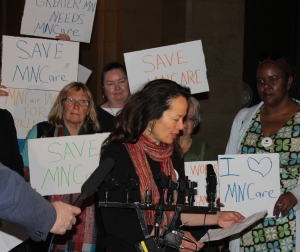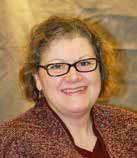Legislative Update May 1, 2015
House HHS Omnibus Bill
Tuesday night, the House passed its Health and Human Services omnibus bill (HF 1638). The bill includes many of MNA’s issues in various forms:
MinnesotaCare is dropped all together. This is the insurance program for about 90,000 Minnesotans who make too much money for Medicaid but not enough to buy insurance through an exchange (approximately 134-200% of the Federal Poverty Level or about $40,000 for a family of four). Another bill, HF 848, includes tax credits for those dropped from MinnesotaCare to get coverage through the private market or MNsure. Unfortunately, the proposed credits aren’t nearly enough to provide an equal level of care. As a result, MinnesotaCare recipients could face high deductibles and co-pays, which could cause them to forego even routine care or just go broke trying to pay for care when they really need it.
CEMT is in the House version, which contains some but not all the language MNA fought for that would prevent Community Emergency Medical Technicians from practicing nursing skills. This bill allows CEMTs to check on and help newly discharged patients. Because there is a provision in the bill that requires a workgroup to make recommendations to the Legislature on what services will be eligible for reimbursement, MNA will continue to advocate in that workgroup that these services not infringe on the nursing scope of practice.
Temporary license suspension is also in the House HHS Omnibus bill. This language raises the level of threat a nurse or healthcare worker must pose to patients before that license holder can be suspended without a hearing.
Senate HHS Omnibus bill
Last week, the Senate passed its all-encompassing HHS bill, which includes these MNA issues:
Workplace Violence Prevention Bill
The bill, which would require all Minnesota hospitals to have a workplace violence prevention plan and provide training to workers on an annual basis. Despite a push from nurses and legislators, the data on incidents will only be accessible to collective bargaining representatives and law enforcement.
Healthcare Task Force
This bill echoes the Governor’s proposal to create a task force that will look at other ways to pay for healthcare in Minnesota. This analysis will look at many options. We hope it will include a study on the savings that could be brought by a Single Payer system. MNA will work to ensure this proposal is in the final budget and to see that nurses are well represented on the task force.
MinnesotaCare
The program continues to operate in this version of the bill, but will face intense pressure and scrutiny as the conference committee decides its fate
Biennial Budget
Two and a half weeks to go in this Legislative Session, and the time to create a budget is growing short. The GOP-led House passed its tax bill Wednesday with a vote along straight party lines. The GOP budget cuts taxes for big business, including eliminating the corporate property tax all together. Those cuts are being marketed as a middle tax class cut, even though a single, $75,000 a year filer would only get $70 back.
To pay for this, the GOP budget underfunds education, and Greater Minnesota doesn’t get broadband, schools, or train safety. In addition, various services offered through HHS would be cut by $1.1 billion. At a time when we have a $2 billion surplus that could help to move Minnesota forward, their proposed shifts and gimmicks could return us to the deficit days that forced Minnesota to borrow from schools again and again. Stay tuned on the response from the DFL-led Senate and the Governor’s office. It appears this budget won’t be settled until the final hours on May 17.
MNA nurses joined TakeAction Minnesota and many other groups to oppose the elimination of MinnesotaCare in the House HHS budget at a press conference on Tuesday. MNA Executive Director Rose Roach explained the impact of the cuts on Minnesota’s patients.
See clips from the conference here
Rape Kit Inventory
Law enforcement agencies are sitting on hundreds of untested rape kits that could be used to bring suspects to justice. The bill that would look into the status of untested rape kits passed the Senate floor by a unanimous vote. The bill also passed the House on Tuesday with the same language in the Public Safety Committee’s omnibus bill. There are concerns that some gun-related issues are riding on the omnibus bill, which could tie up this bill as well. The Governor will have trouble signing it with those riders. If that happens, there will be a push to hear the Rape Kit Inventory as a stand-alone bill.
Voter Pre-Registration
The bill that would allow 16-year-old to register to vote before they turn 18 has made it into the Senate Elections omnibus bill but not the House version.

Wednesdays at the Capitol
This week, nurses from Children’s Hospitals in St. Paul and Minneapolis teamed up to talk to legislators, and they got a great response from their state representatives and senators. Every Wednesday, we bring small groups of nurses to the Capitol to meet with legislators about our priority bills. All MNA members are welcome.
Nurses in attendance will meet at the MNA office in the morning for a briefing and quick training on how to talk to legislators. They then carpool to the Capitol to talk to elected officials about the need for Safe Patient Standard and Workplace Violence Prevention legislation. At around 1 p.m., the group returns to the MNA office for lunch and a debrief of the day. Please contact Geri Katz geri.katz@mnnurses.org or Eileen Gavin eileen.gavin@mnnurses.org for more information or to sign up.











